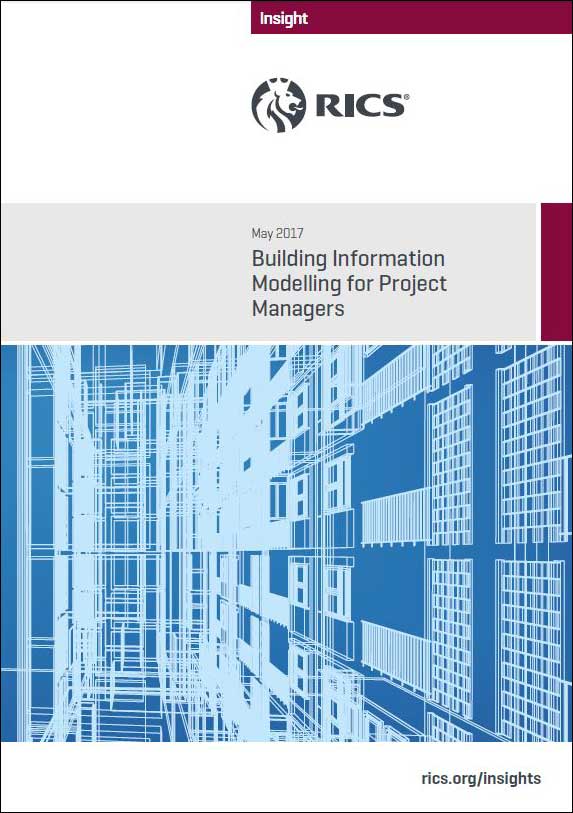This year’s NBS National BIM Report paints a picture of BIM adoption in a maturing market – awareness is almost universal and adoption steadily increasing. However it’s fair to say that mainstream focus has been on front-end use of BIM in design and to reap fullest rewards that focus now needs to be broader. And the role of the project manager is a pretty good place to start.

Enter a new Insight paper from RICS – Building Information Modelling for Project Managers - that explores the project manager’s role in BIM implementation and project delivery and the changes required to existing roles, responsibilities and practices.
There’s advice on organisational planning for implementation and how the project manager can facilitate this right now. There’s horizon-scanning to be had too as the paper explores how the project manager has a pivotal role to play in keeping abreast of emerging technologies and what these technologies mean for revised project management competencies.
Download BIM for Project Managers
Here we share some key takeaways on the role of the project manager and their role in driving the digital construction revolution.
What role can project managers play in successful BIM implementation?
The RICS Assessment of Professional Competence (APC) Pathway Guide on Project Management states that “project managers occupy a central role in the development process driving successful completion of projects”.
In a BIM world, the role of the project manager is arguably more important than ever. Successful project managers should improve communication, co-ordination and collaboration on projects – the very things at the heart of a BIM approach. BIM therefore offers an opportunity to improve collaboration, shared ownership and bring the project, design and BIM strategies together as a cohesive and co-ordinated whole.
As natural facilitators and inquisitors it is the project manager who can cajole, persuade and enforce the use of a common data environment and shared data which will achieve ultimate efficiencies. To do this successfully, project managers need to be front and centre of an organisational BIM debate and their roles, responsibilities and practices need to align with changes in the wider industry – both now and in the future.
What role do project managers play in delivering a successful BIM project?
While not normally involved in model authoring the project manager is, rather, responsible for ensuring that the key elements required to deliver a successful project are present and correct and, necessarily, spans much of the project lifecycle.
The delivery of a project information model (PIM) (formed from the design intent and virtual construction models) need to be considered as part of the project management process. It is the project manager too who over sees delivery of the Asset Information Model (AIM) at handover.
The project manager must ensure, through questioning, prompting, and implementing process, that the appropriate project activities are implemented at the right time, in the right way, by the right project team members.
What role do project managers have in setting overall BIM strategy for the future?
The role of the project manager is pivotal and can be instrumental. There’s potential to guide an organisation at a strategic level on the kind of organisational transformation that is necessary to facilitate a BIM approach that delivers most benefits.
The BIM ‘label’ can be restrictive – this is, after all, organisational transformation, and will impact on people, process and technology. In effect, BIM is something of a Trojan horse for exploration of wider digital technologies and how they can be applied to deliver business benefits. The project manager has the potential to be pivotal in this exploration process, and not only the implementation.
How must project management change to facilitate digital construction?
There are undoubtedly new considerations for project management as organisations move to adopt and engage with others as part of a BIM approach.
Roles and responsibilities as well as project management practice (at organisational and project level) need to be re-evaluated. There are new external dimensions to consider too – engaging with others to facilitate the smooth flow of information across the project lifecycle.
With focus on the model and the information that drives it, the project manager is responsible for facilitating the model-centric delivery process. The project manager too, given their holistic view of a project, is ideally placed to push for operational efficiency in terms of the traditional management of project as well as the BIM implementation process itself.
This requires project management as a discipline to consider both the internal and external implications of BIM. Internally there is a need for project managers to re-evaluate their role, responsibilities, and project management practices both at the project level and at the organisational level. Externally they must take on their role as a “project integrator” facilitating the use of BIM across the entire lifecycle of projects.


